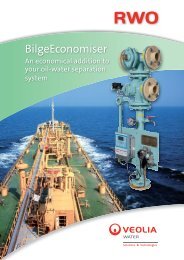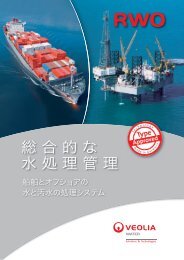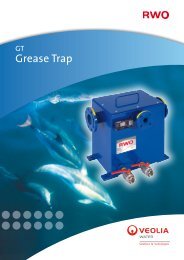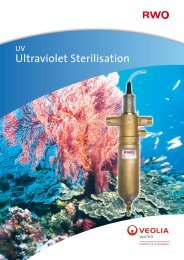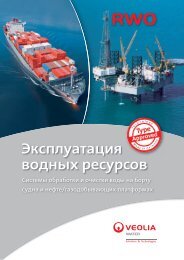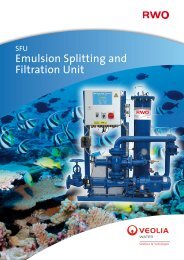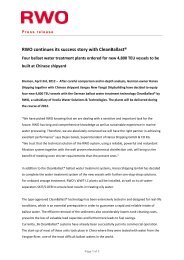the IHS Ballast Water Guide - RWO Marine Water Technology
the IHS Ballast Water Guide - RWO Marine Water Technology
the IHS Ballast Water Guide - RWO Marine Water Technology
You also want an ePaper? Increase the reach of your titles
YUMPU automatically turns print PDFs into web optimized ePapers that Google loves.
<strong>IHS</strong> Fairplay Solutions <strong>Guide</strong> to <strong>Ballast</strong> <strong>Water</strong> Treatment Systems Sponsored by<br />
efficient and compact. With a smaller onboard<br />
footprint and lower energy consumption, <strong>the</strong><br />
BWMS is expected to appeal to shipowners<br />
that need to discharge high volumes of<br />
ballast water in a short period of time using g a<br />
compact system.<br />
Gas Lift Diffusion<br />
Coldharbour <strong>Marine</strong><br />
2 6<br />
Designed primarily for tankers, UK-based<br />
Coldharbour <strong>Marine</strong>’s system operates with<br />
‘in-tank’ ra<strong>the</strong>r than in-line components.<br />
There are no mechanical filters to block or<br />
backflush, no additional seawater valves and<br />
no complex electrical systems. Untreated<br />
water is drawn into a diffusion pipe from<br />
<strong>the</strong> base of <strong>the</strong> ballast tank, while inert<br />
gas is pumped into a gas lift diffuser that<br />
strips oxygen, lowers pH and kills aerobic<br />
and anaerobic organisms and e-coli through<br />
hypercapnia and ultrasonics.<br />
The Coldharbour BWT system uses <strong>the</strong> gas<br />
output from <strong>the</strong> Coldharbour Sea Guardian<br />
marine inert gas generator (IGG), which is<br />
linked to specially designed gas lift diffusion<br />
(GLD) pipe assemblies mounted inside <strong>the</strong><br />
ship’s ballast tanks. GLD technology has no<br />
moving parts.<br />
Sea Guardian is designed to generate ultraclean,<br />
very-low-oxygen inert gas. It is compact<br />
and largely maintenance-free. During <strong>the</strong><br />
voyage, <strong>the</strong> output from <strong>the</strong> IGG is pumped<br />
by standard marine compressors to <strong>the</strong> GLD<br />
units in <strong>the</strong> ballast tanks where <strong>the</strong> full<br />
treatment takes place.<br />
The GLD units use natural fluid dynamics<br />
to both stir <strong>the</strong> ballast tanks and infuse <strong>the</strong><br />
inert gas. The company says <strong>the</strong> system is able<br />
to cope with any depth of ballast within <strong>the</strong><br />
tank, and any silt or sediments that may enter<br />
<strong>the</strong> ballast tank do not affect GLD operation.<br />
It is also equally effective in freshwater.<br />
Blue Ocean Shield<br />
COSCO 1 2 3<br />
Blue Ocean Shield (BOS) is a modularised<br />
ballast water treatment system, designed<br />
and developed by China Ocean Shipping<br />
Company (COSCO) Shipbuilding toge<strong>the</strong>r<br />
with Tsinghua University.<br />
The BOS system can run in different<br />
configurations depending on <strong>the</strong> level<br />
of treatment required and <strong>the</strong> particular<br />
properties of <strong>the</strong> ballast water, by employing<br />
filtration and UV and introducing a<br />
hydrocyclone if required.<br />
The system operates in-line during <strong>the</strong><br />
uptake and discharge of ballast water. Before<br />
UV treatment takes place, a filter system<br />
reduces <strong>the</strong> sediment load of <strong>the</strong> ballast<br />
water, in addition to removing some microorganisms.<br />
The filtration system is installed<br />
on <strong>the</strong> discharge side of <strong>the</strong> ballast water<br />
pumps and is fully automatic in terms of its<br />
cleaning operation. The UV unit employs<br />
high-output, low-pressure ultraviolet (LPUV)<br />
lamps to destroy living micro-organisms<br />
present in <strong>the</strong> ballast water.<br />
<strong>Ballast</strong> water is treated at intake and<br />
again at discharge. The treatment on intake<br />
ensures that a minimal amount of viable<br />
organisms enter <strong>the</strong> ballast water tanks and<br />
reduces sediment build-up in <strong>the</strong> tank. The<br />
water is treated again at discharge only by<br />
<strong>the</strong> UV system to ensure that <strong>the</strong> potential<br />
regrowth of organisms in <strong>the</strong> ballast water<br />
tanks is decreased as much ch as po possib po possible. ib ible. .<br />
Ocean Guard<br />
Desmi<br />
2 3 8<br />
The Ocean Guard system from Desmi consists<br />
of three units.<br />
First, a filtration unit removes particles,<br />
zooplankton and large algae, and comes in<br />
16 © <strong>IHS</strong> Global Limited 2012<br />
012_037_CorrectedBW1204.indd 16 01/08/2012 15:31:20



